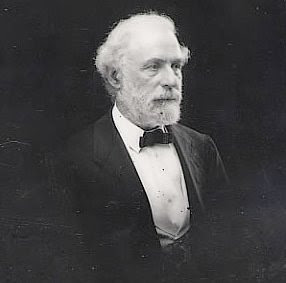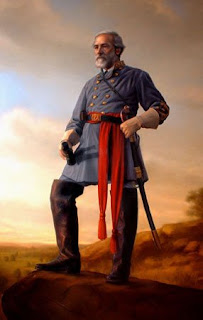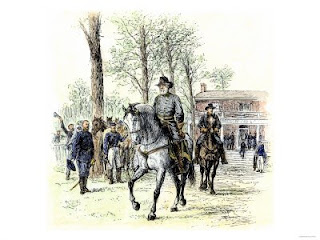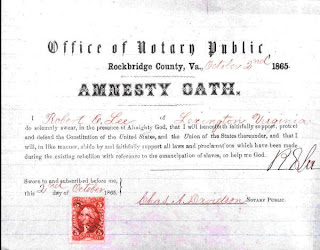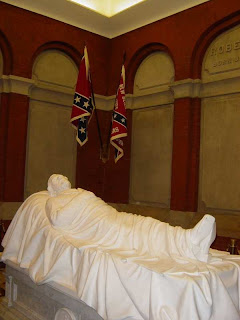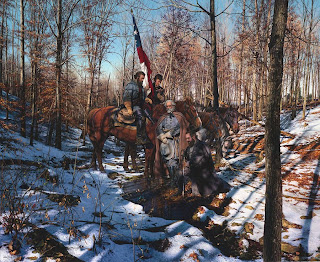.
Ron Duke of West Virginia
versus
Mayor Mitch Landrieu of New Orleans
It seems our sad state of polarization and dissension have manifested once again in the form of political opposition to the existence of Confederate Monuments. The left want them to come down. In certain cases, they were erected as a final testament to the loss of the Civil War, which reflected the battle over slavery, though it was not the only issue behind the Civil War.
There also was a tremendous economic issue involved which seems to be forgotten. England and France, after losing to the American colonists, quickly adapted after the Revolution and when they were not trying to undermine our new nation, they were most certainly using us to build their own wealth and power.
When Lincoln won the presidency and took office, he was greeted by seven states seceding from the United States. When he called for volunteers to fight to preserve the union three more states left. Lincoln's response was to put a naval blockade around the Southern Ports in order to cutoff tobacco and cotton trade with Europe.
Within a few short weeks millions of employees were out of work in England and France, a devastating blow to their economies. From that point on the two European nations were committed to bringing down this nation of rag tag subjects.
So deep was their commitment to the South that when the war was beginning to look like a Southern victory was possible, at the time of the battle at Gettysburg, England and France had moved troops into North America, Canada and Mexico respectively. A top secret and stunning diplomatic effort by Lincoln brought the Czar of Russia into the action on the side of the Union and forced the two European nations to stay out of the conflict.
That is a story for another day.
Today, 152 years since the Civil War was won by the Union, the battle over the Confederacy seems to be renewed. There are some who argue that all Confederate Civil War statues and Monuments must come down in the interest of political correctness.
The following are two viewpoints on this issue, one by a West Virginia native, historian, and Kentucky resident, Ron Duke, and the other by Mayor Mitch Landrieu of New Orleans. I hope you find these helpful in understanding the problem facing much of the South and a few states in the North.
Ron Duke, West Virginia native, historian, and Kentucky resident
Statues and Words
Statues and words are two things that meaning is sure to change over time. Today confederate statues,
veritable loser trophies from 100-120 years ago, become an icon of not
accepting Trump for President. The Democrats can't change the President but
they can make small towns all over the south, that's where the Confederate
civil war statues are located, take down or move the participation award from
some previous generation.
How is this similar to
words. Well take the word bad. Someone who makes you do something you might not
have done otherwise in slang is a bad dude. Bad might be a very nice car or it
might be a deed you did that was not a good deed. The number of words
associated with bad has increased over the last hundred years. It was a natural
evolution of language. Meaning changes over time.
One of the first thing a
victorious army does when it annexes conquered territory is to force the locals
to use the victors language. This is the real goal of the leadership in the
liberal response to trump. The people who want to limit the meaning of public
art and language in general understand that those who control language control
the discussion. There is no rule that says only the winners of wars need be
commemorated or a person depicted in a statue has to be a modern saint.
Our
past is what it is and any attempt to control the language and iconography are
attempts to manipulate the present. To destroy the icons of our past are to
forget the hard lessons of our fore-bearers. The left's attempts to destroy these
few statues has nothing to do with racism and injustice in the land and has
everything to do with trying to tar the opposition as sympathetic to racists,
bigots, and all sorts of malaprops.
In politics when a
campaign goes negative it is a sign they are losing. The only way they can win
is to make the other side look like a dirtier dog than the dirty dog they
became. The Democrats know very well how far behind they are now. The level of
bile thrown at Trump is public proof of the desperation of the Democrats. They
are so far behind they don't have another choice. The internet is still
relatively free and we as free people can still talk to each other.
Thanks be
to God.
Ronald W. Duke-
Principal Broker
Kentucky Real Estate and
Finance
What will be next to go, Slave owner statues?
TRANSCRIPT OF NEW ORLEANS MAYOR LANDRIEU’S ADDRESS ON CONFEDERATE MONUMENTS
Mayor Mitch Landrieu New Orleans
May 23, 2017
Just hours before workers removed a statue of Confederate
general Robert E. Lee — the fourth Confederate monument to be
dismantled in New Orleans in recent weeks — Mayor Mitch Landrieu gave a
special address at historic Gallier Hall.
Here’s a full transcript of Landrieu’s remarks:
Thank you for coming.
The soul of our beloved
City is deeply rooted in a history that has evolved over thousands of years;
rooted in a diverse people who have been here together every step of the way –
for both good and for ill.
It is a history that
holds in its heart the stories of Native Americans: the Choctaw, Houma Nation,
the Chitimacha. Of Hernando de Soto, Robert Cavelier, Sieur de La Salle,
the Acadians, the Islenos, the enslaved people from Senegambia, Free People of
Color, the Haitians, the Germans, both the empires of Francexii and Spain. The
Italians, the Irish, the Cubans, the south and central Americans, the
Vietnamese and so many more.
You see: New Orleans is
truly a city of many nations, a melting pot, a bubbling cauldron of many
cultures.
There is no other place
quite like it in the world that so eloquently exemplifies the uniquely American
motto: e pluribus unum — out of many we are one.
But
there are also other truths about our city that we must confront. New
Orleans was America’s largest slave market: a port where hundreds of thousands
of souls were brought, sold and shipped up the Mississippi River to lives of
forced labor of misery of rape, of torture.
America
was the place where nearly 4,000 of our fellow citizens were lynched, 540 alone
in Louisiana; where the courts enshrined ‘separate but equal’; where Freedom
riders coming to New Orleans were beaten to a bloody pulp.
So when
people say to me that the monuments in question are history, well what I just
described is real history as well, and it is the searing truth.
And it
immediately begs the questions: why there are no slave ship monuments, no
prominent markers on public land to remember the lynchings or the slave blocks;
nothing to remember this long chapter of our lives; the pain, the sacrifice,
the shame … all of it happening on the soil of New Orleans.
So for
those self-appointed defenders of history and the monuments, they are eerily
silent on what amounts to this historical malfeasance, a lie by omission.
There
is a difference between remembrance of history and reverence of it. For
America and New Orleans, it has been a long, winding road, marked by great
tragedy and great triumph. But we cannot be afraid of our truth.
As
President George W. Bush said at the dedication ceremony for the National
Museum of African American History & Culture, “A great nation does not hide
its history. It faces its flaws and corrects them.”
So
today I want to speak about why we chose to remove these four monuments to the
Lost Cause of the Confederacy, but also how and why this process can move us
towards healing and understanding of each other.
So,
let’s start with the facts.
The
historic record is clear: the Robert E. Lee, Jefferson Davis, and P.G.T.
Beauregard statues were not erected just to honor these men, but as part of the
movement which became known as The Cult of the Lost Cause. This ‘cult’ had
one goal — through monuments and through other means — to rewrite history
to hide the truth, which is that the Confederacy was on the wrong side of
humanity.
First
erected over 166 years after the founding of our city and 19 years after the
end of the Civil War, the monuments that we took down were meant to rebrand the
history of our city and the ideals of a defeated Confederacy.
It is
self-evident that these men did not fight for the United States of America,
They fought against it. They may have been warriors, but in this cause they
were not patriots.
These
statues are not just stone and metal. They are not just innocent remembrances
of a benign history. These monuments purposefully celebrate a fictional,
sanitized Confederacy; ignoring the death, ignoring the enslavement, and the
terror that it actually stood for.
After
the Civil War, these statues were a part of that terrorism as much as a burning
cross on someone’s lawn; they were erected purposefully to send a strong
message to all who walked in their shadows about who was still in charge in
this city.
Should
you have further doubt about the true goals of the Confederacy, in the very
weeks before the war broke out, the Vice President of the Confederacy,
Alexander Stephens, made it clear that the Confederate cause was about
maintaining slavery and white supremacy.
He said
in his now famous ‘Cornerstone speech’ that the Confederacy’s “cornerstone
rests upon the great truth, that the negro is not equal to the white man; that
slavery — subordination to the superior race — is his natural and
normal condition. This, our new government, is the first, in the history of the
world, based upon this great physical, philosophical, and moral truth.”
Now,
with these shocking words still ringing in your ears, I want to try to
gently peel from your hands the grip on a false narrative of our history that I
think weakens us and make straight a wrong turn we made many years ago so we
can more closely connect with integrity to the founding principles of our
nation and forge a clearer and straighter path toward a better city and more perfect
union.
Last
year, President Barack Obama echoed these sentiments about the need to
contextualize and remember all of our history. He recalled a piece of
stone, a slave auction block engraved with a marker commemorating a single
moment in 1830 when Andrew Jackson and Henry Clay stood and spoke from it.
President
Obama said, “Consider what this artifact tells us about history … on a stone
where day after day for years, men and women … bound and bought and sold and
bid like cattle on a stone worn down by the tragedy of over a thousand bare
feet. For a long time the only thing we considered important, the singular
thing we once chose to commemorate as history with a plaque were the
unmemorable speeches of two powerful men.”
A piece
of stone – one stone. Both stories were history. One story
told. One story forgotten or maybe even purposefully ignored.
As
clear as it is for me today … for a long time, even though I grew up in one of
New Orleans’ most diverse neighborhoods, even with my family’s long proud history
of fighting for civil rights … I must have passed by those monuments a million
times without giving them a second thought.
So I am
not judging anybody, I am not judging people. We all take our own journey on
race. I just hope people listen like I did when my dear friend Wynton Marsalis
helped me see the truth. He asked me to think about all the people who
have left New Orleans because of our exclusionary attitudes.
Another
friend asked me to consider these four monuments from the perspective of an
African American mother or father trying to explain to their fifth grade
daughter who Robert E. Lee is and why he stands atop of our beautiful
city. Can you do it?
Can you
look into that young girl’s eyes and convince her that Robert E. Lee is there
to encourage her? Do you think she will feel inspired and hopeful by that
story? Do these monuments help her see a future with limitless potential?
Have you ever thought that if her potential is limited, yours and mine are too?
We all
know the answer to these very simple questions.
When
you look into this child’s eyes is the moment when the searing truth comes into
focus for us. This is the moment when we know what is right and what we must
do. We can’t walk away from this truth.
And I
knew that taking down the monuments was going to be tough, but you elected me
to do the right thing, not the easy thing and this is what that looks like. So
relocating these Confederate monuments is not about taking something away from
someone else. This is not about politics, this is not about blame or
retaliation. This is not a naïve quest to solve all our problems at once.
This
is, however, about showing the whole world that we as a city and as a people
are able to acknowledge, understand, reconcile and, most importantly, choose a
better future for ourselves, making straight what has been crooked and making
right what was wrong.
Otherwise,
we will continue to pay a price with discord, with division, and yes, with
violence.
To
literally put the confederacy on a pedestal in our most prominent places of
honor is an inaccurate recitation of our full past, it is an affront to our
present, and it is a bad prescription for our future.
History
cannot be changed. It cannot be moved like a statue. What is done is done. The
Civil War is over, and the Confederacy lost and we are better for it. Surely we
are far enough removed from this dark time to acknowledge that the cause of the
Confederacy was wrong.
And in
the second decade of the 21st century, asking African Americans — or
anyone else — to drive by property that they own; occupied by reverential
statues of men who fought to destroy the country and deny that person’s
humanity seems perverse and absurd.
Centuries-old
wounds are still raw because they never healed right in the first place.
Here is
the essential truth: we are better together than we are
apart. Indivisibility is our essence. Isn’t this the gift that the
people of New Orleans have given to the world?
We
radiate beauty and grace in our food, in our music, in our architecture, in our
joy of life, in our celebration of death; in everything that we do. We
gave the world this funky thing called jazz; the most uniquely American art
form that is developed across the ages from different cultures.
Think
about second lines, think about Mardi Gras, think about muffaletta, think about
the Saints, gumbo, red beans and rice. By God, just think. All we
hold dear is created by throwing everything in the pot; creating, producing
something better; everything a product of our historic diversity.
We are
proof that out of many we are one — and better for it! Out of many we are one
— and we really do love it!
And
yet, we still seem to find so many excuses for not doing the right thing.
Again, remember President Bush’s words, “A great nation does not hide its
history. It faces its flaws and corrects them.”
We
forget, we deny how much we really depend on each other, how much we need each
other. We justify our silence and inaction by manufacturing noble causes
that marinate in historical denial. We still find a way to say “wait, not
so fast.”
But
like Dr. Martin Luther King Jr. said, “wait has almost always meant never.”
We
can’t wait any longer. We need to change. And we need to change now. No more
waiting. This is not just about statues, this is about our attitudes and
behavior as well. If we take these statues down and don’t change to become
a more open and inclusive society this would have all been in vain.
While
some have driven by these monuments every day and either revered their beauty
or failed to see them at all, many of our neighbors and fellow Americans see
them very clearly. Many are painfully aware of the long shadows their
presence casts, not only literally but figuratively. And they clearly
receive the message that the Confederacy and the cult of the lost cause
intended to deliver.
Earlier
this week, as the cult of the lost cause statue of P.G.T Beauregard came down,
world renowned musician Terence Blanchard stood watch, his wife Robin and their
two beautiful daughters at their side.
Terence
went to a high school on the edge of City Park named after one of America’s
greatest heroes and patriots, John F. Kennedy. But to get there he had to
pass by this monument to a man who fought to deny him his humanity.
He
said, “I’ve never looked at them as a source of pride … it’s always made me
feel as if they were put there by people who don’t respect us. This is something
I never thought I’d see in my lifetime. It’s a sign that the world is
changing.”
Yes,
Terence, it is, and it is long overdue.
Now is
the time to send a new message to the next generation of New Orleanians who can
follow in Terence and Robin’s remarkable footsteps.
A
message about the future, about the next 300 years and beyond; let us not miss
this opportunity New Orleans and let us help the rest of the country do the
same. Because now is the time for choosing. Now is the time to
actually make this the City we always should have been, had we gotten it right
in the first place.
We
should stop for a moment and ask ourselves — at this point in our
history, after Katrina, after Rita, after Ike, after Gustav, after the
national recession, after the BP oil catastrophe and after the tornado
— if presented with the opportunity to build monuments that told our story
or to curate these particular spaces … would these monuments be what we want
the world to see? Is this really our story?
We have
not erased history; we are becoming part of the city’s history by righting the
wrong image these monuments represent and crafting a better, more complete
future for all our children and for future generations.
And
unlike when these Confederate monuments were first erected as symbols of white
supremacy, we now have a chance to create not only new symbols, but to do it
together, as one people.
In our
blessed land we all come to the table of democracy as equals.
We have
to reaffirm our commitment to a future where each citizen is guaranteed the
uniquely American gifts of life, liberty and the pursuit of happiness.
That is
what really makes America great and today it is more important than ever to
hold fast to these values and together say a self-evident truth that out of
many we are one. That is why today we reclaim these spaces for the United
States of America.
Because
we are one nation, not two; indivisible with liberty and justice for all, not
some. We all are part of one nation, all pledging allegiance to one flag,
the flag of the United States of America. And New Orleanians are in, all
of the way.
It is
in this union and in this truth that real patriotism is rooted and flourishes.
Instead
of revering a 4-year brief historical aberration that was called the
Confederacy we can celebrate all 300 years of our rich, diverse history as a
place named New Orleans and set the tone for the next 300 years.
After
decades of public debate, of anger, of anxiety, of anticipation, of humiliation
and of frustration. After public hearings and approvals from three
separate community led commissions. After two robust public hearings and a
6-1 vote by the duly elected New Orleans City Council. After review by 13
different federal and state judges. The full weight of the legislative,
executive, and judicial branches of government has been brought to bear and the
monuments in accordance with the law have been removed.
So now
is the time to come together and heal and focus on our larger task. Not only
building new symbols, but making this city a beautiful manifestation of what is
possible and what we as a people can become.
Let us
remember what the once exiled, imprisoned and now universally loved
Nelson Mandela and what he said after the fall of apartheid. “If the pain
has often been unbearable and the revelations shocking to all of us, it
is because they indeed bring us the beginnings of a common understanding
of what happened and a steady restoration of the nation’s humanity.”
So
before we part let us again state the truth clearly.
The
Confederacy was on the wrong side of history and humanity. It sought to tear
apart our nation and subjugate our fellow Americans to slavery. This is the
history we should never forget and one that we should never again put on a
pedestal to be revered.
As a
community, we must recognize the significance of removing New Orleans’
Confederate monuments. It is our acknowledgment that now is the time to
take stock of, and then move past, a painful part of our history. Anything
less would render generations of courageous struggle and soul-searching a truly
lost cause.
Anything
less would fall short of the immortal words of our greatest President Abraham
Lincoln, who with an open heart and clarity of purpose calls on us today to
unite as one people when he said:
“With
malice toward none, with charity for all, with firmness in the right as God
gives us to see the right, let us strive on to finish the work we are in, to
bind up the nation’s wounds, to do all which may achieve and cherish: a just
and lasting peace among ourselves and with all nations.”
Thank
you.
